When the Butterfly Feeds on the Flowers
All about butterflies
Index
What is a butterfly?
What is the difference between a butterfly and a moth?
What type of life cycle does a butterfly have?
What are some butterfly activities that are commonly observed?
- feeding
- basking
- puddling
- patrolling and perching
- mating
- egg laying
- hybernating
- migrating
- a note about camouflage
Butterfly words (glossary)
Back to Butterfly Gardening Home Page
Note: Words underlined in the text are defined in the "Butterfly words" or glossary section.
What is a butterfly?
Butterflies are the adult flying stage of certain insects belonging to an order or group called Lepidoptera. Moths also belong to this group. The word "Lepidoptera" means "scaly wings" in Greek. This name perfectly suits the insects in this group because their wings are covered with thousands of tiny scales overlapping in rows. The scales, which are arranged in colorful designs unique to each species, are what gives the butterfly its beauty.
Like all other insects, butterflies have six legs and three main body parts: head, thorax (chest or mid section) and abdomen (tail end). They also have two antennae and an exoskeleton.
The difference between a butterfly and a moth?
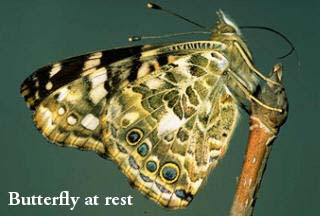
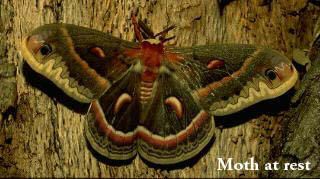
Both butterflies and moths belong to the same insect group called Lepidoptera. In general, butterflies differ from moths in the following ways: (1) Butterflies usually have clubbed antennae but moths have fuzzy or feathery antennae. (2) Butterflies normally are active during the daytime while most moths are active at night. (3) When a butterfly rests, it will do so with its wings held upright over its body. Moths, on the other hand, rest with their wings spread out flat. Butterflies will, however,
with their wings out-stretched. (4) Butterflies are generally more brightly colored than moths, however, this is not always the case. There are some very colorful moths.
Butterfly life cycle
Alife cycle is made up of the stages that a living organism goes through during its lifetime from beginning to end. A butterfly undergoes a process called completemetamorphosis during its life cycle. This means that the butterfly changes completely from its early larval stage, when it is a caterpillar, until the final stage, when it becomes a beautiful and graceful adult butterfly. The butterfly life cycle has four stages:egg,larva,pupa, andadult.
 The first stage of the butterfly life cycle is theegg orovum. Butterfly eggs are tiny, vary in color and may be round, cylindrical or oval. The female butterfly attaches the eggs to leaves or stems of plants that will also serve as a suitable food source for the larvae when they hatch.
The first stage of the butterfly life cycle is theegg orovum. Butterfly eggs are tiny, vary in color and may be round, cylindrical or oval. The female butterfly attaches the eggs to leaves or stems of plants that will also serve as a suitable food source for the larvae when they hatch.
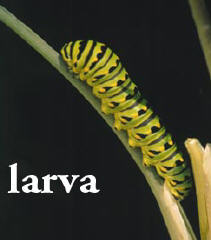
The larva, orcaterpillar, that hatches from the egg is the second stage in the life cycle. Caterpillars often, but not always, have several pairs of true legs, along with several pairs of false legs or prolegs. A caterpillar's primary activity is eating. They have a voracious appetite and eat almost constantly. As the caterpillar continues to eat, its body grows considerably. The tough outer skin or exoskeleton, however, does not grow or stretch along with the enlarging caterpillar. Instead, the old exoskeleton is shed in a process called molting and it is replaced by a new, larger exoskeleton. A caterpillar may go through as many as four to five molts before it becomes a pupa.
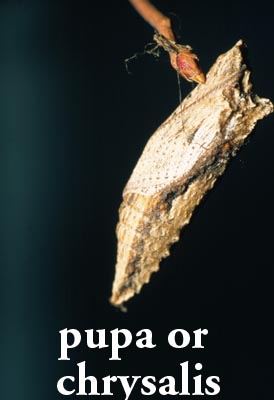
The third stage is known as thepupa orchrysalis. The caterpillar attaches itself to a twig, a wall or some other support and the exoskeleton splits open to reveal the chrysalis. The chrysalis hangs down like a small sack until the transformation to butterfly is complete. The casual observer may think that because the pupa is motionless that very little is going on during this "resting stage." However, it is within the chrysalis shell that the caterpillar's structure is broken down and rearranged into the wings, body and legs of the adult butterfly. The pupa does not feed but instead gets its energy from the food eaten by the larval stage. Depending on the species, the pupal stage may last for just a few days or it may last for more than a year. Many butterfly species overwinter orhibernate as pupae.
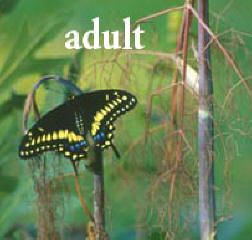
The fourth and final stage of the life cycle is theadult. Once the chrysalis casing splits, the butterfly emerges. It will eventually mate and lay eggs to begin the cycle all over again. Most adult butterflies will live only a week or two, while a few species may live as long as 18 months.
Images in this section are of the life cycle of the black swallowtail on one of its host plants, fennel. Images are from Kentucky Cooperative Extension Service Publication FOR-98, Attracting Butterflies with Native Plants, by Thomas G. Barnes.
Back to index
Butterfly activities
Butterflies are complex creatures. Their day-to-day lives can be characterized by many activities. If you are observant you may see butterflies involved in many of the follow activities. To observe some activities, such as hybernation, may involve some detective work. To observe other activities such as basking, puddling, or migrating, you will need to be at the proper place at the proper time. Keep an activity log and see how many different butterflies you can spot involved in each activity. The information from the individual butterfly pages may give you some hints as to where (or on what plants) some of these activities are likely to occur.
Back to index
Feeding
The larval or caterpillar stage and the adult butterfly have very different food preferences, largely due to the differences in their mouth parts. Both types of foods must be available in order for the butterfly to complete its life cycle.
Caterpillars are very particular about what they eat, which is why the female butterfly lays her eggs only on certain plants. Sheinstinctively knows what plants will serve as suitable food for the hungry caterpillars that hatch from her eggs. Caterpillars don't move much and may spend their entire lives on the same plant or even the same leaf! Their primary goal is to eat as much as they can so that they become large enough to pupate. Caterpillars have chewing mouth parts, calledmandibles, which enable them to eat leaves and other plant parts. Some caterpillars are considered pests because of the damage they do to crops. Caterpillars do not need to drink additional water because they get all they need from the plants they eat.
Adult butterflies are also selective about what they eat. Unlike caterpillars, butterflies can roam about and look for suitable food over a much broader territory. In most cases, adult butterflies are able to feed only on various liquids. They drink through a tube-like tongue called aproboscis. It uncoils to sip liquid food, and then coils up again into a spiral when the butterfly is not feeding. Most butterflies prefer flower nectar, but others may feed on the liquids found in rotting fruit, in ooze from trees, and in animal dung. Butterflies prefer to feed in sunny areas protected from wind.
A recent University of Kentucky Department of Entomology study compared four commonly available zinnia cultivars with regard to their attractiveness to butterflies. Click here ***FIX LINK*** to see the results of their study, and a reprint of their findings published in theJournal of Environmental Horticulture.
Back to index
Basking
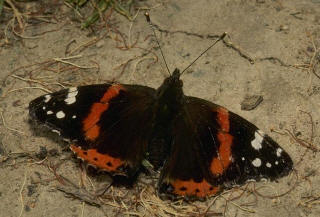 Butterflies arecold-blooded, meaning they cannot regulate their own body temperature. As a result, their body temperature changes with the temperature of their surroundings. If they get too cold, they are unable to fly and must warm up their muscles in order to resume flight. Butterflies can fly as long as the air is between 60°-108° F, although temperatures between 82°-100° F are best. If the temperature drops too low, they may seek a light colored rock, sand or a leaf in a sunny spot and bask. Butterflies bask with their wings spread out in order to soak up the sun's heat.
Butterflies arecold-blooded, meaning they cannot regulate their own body temperature. As a result, their body temperature changes with the temperature of their surroundings. If they get too cold, they are unable to fly and must warm up their muscles in order to resume flight. Butterflies can fly as long as the air is between 60°-108° F, although temperatures between 82°-100° F are best. If the temperature drops too low, they may seek a light colored rock, sand or a leaf in a sunny spot and bask. Butterflies bask with their wings spread out in order to soak up the sun's heat.
Back to index
Puddling
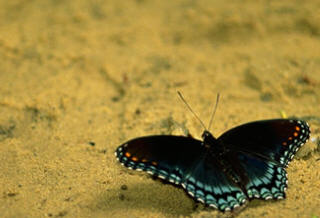 When butterflies get too hot, they may head for shade or for cool areas like puddles. Some species will gather at shallow mud puddles or wet sandy areas, sipping the mineral-rich water. Generally more males than females puddle and it is believed that the salts and nutrients in the puddles are needed for successful mating.
When butterflies get too hot, they may head for shade or for cool areas like puddles. Some species will gather at shallow mud puddles or wet sandy areas, sipping the mineral-rich water. Generally more males than females puddle and it is believed that the salts and nutrients in the puddles are needed for successful mating.
Back to index
Patrolling and perching
There are two methods that a male butterfly might use in order to search for a female mate. It might patrol or fly over a particular area where other butterflies are active. If it sees a possible mate, it will fly in for a closer look. Or, instead, it might perch on a tall plant in an area where females may be present. If it spots a likely mate, it will swoop in to investigate. In either case, if he finds a suitable female he will begin the mating ritual. If he finds another male instead, a fierce fight may ensue.
Back to index
Mating
A male butterfly has several methods of determining whether he has found a female of his own species. One way is by sight. The male will look for butterflies with wings that are the correct color and pattern. When a male sights a potential mate it will fly closer, often behind or above the female. Once closer, the male will release special chemicals, calledpheromones, while it flutters its wings a bit more than usual. The male may also do a special "courtship dance" to attract the female. These "dances" consist of flight patterns that are peculiar to that species of butterfly. If the female is interested she may join the male's dance. They will then mate by joining together end to end at their abdomens. During the mating process, when their bodies are joined, the male passes sperm to the female. As the eggs later pass through the female's egg-laying tube, they are fertilized by the sperm. The male butterfly often dies soon after mating.
Back to index
Egg-laying
After mating with a male, the female butterfly must go in search of a plant on which to lay her eggs. Because the caterpillars that will hatch from her eggs will be very particular about what they eat, she must be very particular in choosing a plant. She can recognize the right plant species by its leaf color and shape. Just to be sure, however, she may beat on the leaf with her feet. This scratches the leaf surface, causing a characteristic plant odor to be released. Once she is sure she has found the correct plant species, she will go about the business of egg-laying. While laying her eggs, they are fertilized with the sperm that has been stored in her body since mating. Some butterflies lay a single egg, while others may lay their eggs in clusters. A sticky substance produced by the female enables the eggs to stick where ever she lays them, either on the underside of a leaf or on a stem.
Back to index
Hibernating
Butterflies are cold-blooded and cannot withstand winter conditions in an active state. Butterflies may survive cold weather by hibernating in protected locations. They may use the peeling bark of trees, perennial plants, logs or old fences as their overwintering sites. They may hibernate at any stage (egg, larval, pupal or adult) but generally each species is dormant in only one stage.
Back to index
Migrating
Another way that butterflies can escape cold weather is by migrating to a warmer region. Some migrating butterflies, such as the painted lady and cabbage butterfly, fly only a few hundred miles, while others, such as the monarch, travel thousands of miles.
Monarchs are considered the long-distance champions of butterfly migration, traveling as many as 4000 miles round trip. They begin their flight before the autumn cold sets in, heading south from Canada and the northern United States. Monarchs migrate to the warmer climates of California, Florida and Mexico, making the trip in two months or less and feeding on nectar along the way. Once arriving at their southern destination, they will spend the winter resting for the return flight. Few of the original adults actually complete the trip home. Instead, the females mate and lay eggs along the way and their offspring finish this incredible journey.
Back to index
Camouflage
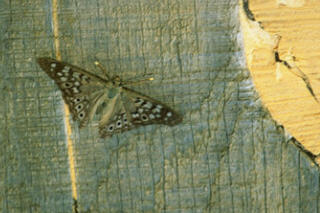 Butterflies and caterpillars are preyed upon by birds, spiders, lizards and various other animals. Largely defenseless against many of these hungry predators, Lepidoptera have developed a number of passive ways to protect themselves. One way is by making themselves inconspicuous through the use of camouflage.
Butterflies and caterpillars are preyed upon by birds, spiders, lizards and various other animals. Largely defenseless against many of these hungry predators, Lepidoptera have developed a number of passive ways to protect themselves. One way is by making themselves inconspicuous through the use of camouflage.
Caterpillars may be protectively colored or have structures that allow them to seemingly disappear into the background. For example, many caterpillars are green, making them difficult to detect because they blend in with the host leaf. Some larvae, particularly those in the Tropics, bear a resemblance to bird droppings, a disguise that makes them unappealing to would-be predators.
The coloration and pattern of a butterfly's wings may enable it to blend into its surrounding. Some may look like dead leaves on a twig when they are at rest with their wings closed. The under wing markings of the comma and question mark butterflies help them to go unnoticed when hibernating in leaf litter.
Back to index
Butterfly Words (Glossary)
Abdomen (noun) - the last segment of an insect's body, located at the tail end. The heart, reproductive organs and much of the digestive system are located in an insect's abdomen.
Adult (noun) - the fully grown or fully developed stage of an animal. A butterfly or moth is the adult stage of a caterpillar.
Antenna (noun, plural: antennae) - one of a pair of slender structures located on the head of some insects. Butterfly antennae are used for balance and for detecting smells and wind speed.
Basking (verb) - the activity where a butterfly rests with outstretched wings in the sunshine in order to absorb as much heat as possible.
Camouflage (noun) - a protective coloring that enables an animal to blend in with its environment, thus hiding it from its predators.
Caterpillar (noun) - the worm-like second stage in a butterfly life cycle, also called a larva.
Chitin (noun, pronounced: KI-tin) - a tough, colorless material that makes up the insect exoskeleton.
Chrysalis (noun - pronounced: KRIS-uh-liss) - the third stage of the butterfly life cycle, also called a pupa.
Cocoon (noun) - the silken protective covering made by a moth larva before it becomes a pupa.
Cold blooded (adjective) - having a body temperature that is about the same as the surrounding air because of the animal's inability to regulate its own internal body heat. On the other hand, warm blooded animals are able to regulate their own internal body heat and their bodies stay at a fairly constant temperature, regardless of their surroundings.
Dormancy (noun) - a period of no activity when development is suspended, often occurring during unfavorable conditions. Also, dormant (verb).
Egg (noun) - the first stage in a butterfly's life cycle. The larva or caterpillar hatches from a butterfly egg.
Exoskeleton (noun) - a tough, external covering made of chitin, which supports the body and protects the internal organs.
Head (noun) - the front body segment of an insect. The mouthparts, eyes and antennae are located here.
Hibernation (noun) - also referred to as overwintering, the act of entering a time of dormancy or inactivity that lasts through a specific period of time (such as a season), enabling an animal to survive through severe weather. Butterflies that hibernate in the winter may do so at any stage of development, depending on the species. Most often, however, hibernation occurs during the pupal stage. Also, hibernate (verb).
Instinct (noun) - a way of behaving that is natural to an animal from birth. The behavior is known without having been taught. Also, instinctively (adverb).
Larva (noun, plural: larvae) - the worm-like second stage of the butterfly life cycle, also called a caterpillar.
Life cycle (noun) - the phases or changes that an insect goes through from the egg stage until its death as an adult.
Mandibles (noun) - tooth-like jaws present in insects with chewing mouthparts. Caterpillars have mandibles, but adult butterflies do not.
Mating (verb) - the pairing of a female and male in order to breed and produce offspring.
Metamorphosis (noun) - the marked changes in appearance and habit that occur during development, from the growing stage(s) to the mature, adult stage. Butterflies undergo "complete metamorphosis" and their appearance changes completely from the larval to adult stage. Insects which go through a "simple metamorphosis", such as a grasshopper, change only gradually in appearance during these stages.
Migration (noun) - the mass movement of an animal species across many miles in order to escape unfavorable conditions. Some butterflies, such as the monarch, may migrate thousands of miles in order to avoid winter conditions. Other types of butterflies may only migrate a relatively short distance. Also, migrate (verb).
Molt (verb) - to lose the old skin or exoskeleton. The insect grows a larger one to replace the one that is shed.
Nectar (noun)- the sugary, sweet liquid produced by many flowers.
Ovum (noun, plural: ova) - egg.
Patrolling (verb) - flying over a specific area in search of a mate.
Perching (verb) - landing on a tall plant or other object for the purpose of searching out a mate.
Pheromone (noun) - a chemical given off by an animal and meant to cause a specific reaction in another of the same species. Butterflies give off pheromones in order to attract a mate.
Proboscis (noun) - a straw-like, flexible tongue that uncoils when the butterfly sips liquid food and then coils up again into a spiral when the butterfly is not feeding.
Proleg (noun) - a fleshy leg or "false leg" attached to the abdomen of certain insect larvae.
Puddling (verb) - sipping nutrient-rich water from puddles. Generally more males that females puddle and it is believed that the salts and nutrients in the puddles are needed for successful mating.
Pupa (noun, pl. pupae) - the third stage of the butterfly life cycle, also called a chrysalis.
Pupate (verb) - to turn into and exist as a pupa.
Scales (noun) - tiny modified hairs which overlap on a butterfly wing. The scales give the butterfly wings their color and beauty.
Stage (noun) - one of the distinct periods in an insect's life. Butterflies have four stages: egg, larva, pupa and adult.
Thorax (noun) - the second segment in an insect's body, located in the mid-section. Butterfly wings and legs are attached to the thorax.
Vein (noun) - the rib-like tubes that give support to insect wings. The veins are tubes mostly filled with air.
Source: https://www.uky.edu/hort/butterflies/all-about-butterflies
0 Response to "When the Butterfly Feeds on the Flowers"
Postar um comentário